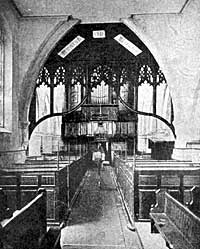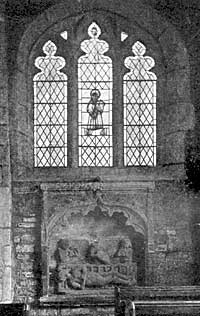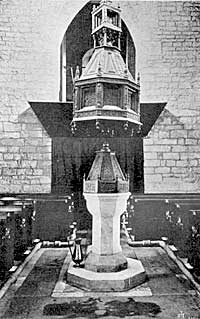
Tuxford church (interior prior to 1877).
On the east wall of the clerestory may be seen the marks of the old high-pitched chancel roof of the earlier Decorated church, and below on the east wall of the south aisle a bit of the old label-mould may be observed.
The chancel is of still later date and of one type. An old inscription, much of which is still to be found in the east window of the chancel, though the remains of it are now somewhat mixed up, ran thus, as recorded by Thoroton, Orate pro anima Thomje Gunthorpe, Prioris de Novo loco in Shirewood, qui cancellam istam sedificavit, Anno Domini MCCCCLXXXXV. Pray for the soul of Thomas Gunthorpe, Prior of Newstead in Sherwood, who built this chancel in the year of our Lord, 1495. This date lies ten years within the Tudor period. The four windows on the south side of this chancel are of this character. They are of three lights with the mullions doubled in number in the head, and the arching is so depressed as to be almost triangular. There is a similar window in the vestry but of modern construction; for prior to 1877 a mere cottage window with square shutters attached, occupied its place. The present vestry door too is modern and a nineteen century structure. The present east window of the chancel is Tudor in character and of five lights with doubled mullions in the head and a segmental arching of very large diameter. None of the tracery in this chancel can be considered good, and I very much doubt whether any of it is original and dating from Prior Gunthorpe's time. Certainly some of the work is quite modern. The coats of arms, mentioned by Thoroton as existing in his day in these chancel windows, have entirely disappeared.
The remaining items of interest, externally are:—A square window above the vestry door with modern iron stanchions, diagonal buttresses to chancel and vestry, the Tudor north door of the chancel, the devil above the chancel buttress, label-mould stops representing king, peasant, lady's head adorned with the wimple; gargoyles, finials, and grotesque heads on a line below the battlements.

Tuxford church (monument and window to St Lawrence).
Last of all we must not forget the two square niches, one on either side of the inserted Early English doorway of the south-west porch, and part of the Perpendicular work thereof. One of them may have contained a figure of the Virgin Mary. There is something of such a figure to be seen on a rude bracket at the east end of the south aisle. The figure is seated and nothing left of it much, but the beautifully carved drapery. The other niche would probably contain a representation of St. Nicholas, the patron saint of the church. He is often represented bearing three purses or three golden balls in memory of the saint's munificence in providing the three daughters of a poor nobleman of Patara with their marriage portions. These same three golden balls became a sign of the Medici family in Florence, later still of the Lombard merchants who settled in England, and in more recent times the well-known pawnbroker's sign. It is a noteworthy example of the decadence of symbols.
Finally there is the north-west porch to glance at—no more—for it is a terrible example of modern Perpendicular imitation work of perhaps forty years ago. The White mausoleum extension is Georgian.
We will therefore return to the interior of the church, where there are still many points of interest to consider.
There were formerly two chantries here, founded by Sir Thomas Longvillers and Sir John Longvillers in 1334, and 1357 respectively. Sir Thomas provided "an endowment for a Cantarist to say masses for his soul and for all the faithful, deceased, each day before sunrise at the altar of S. Mary Magdalene on the north side of the church." This altar would be situated in what is now the White mausoleum and close to the piscina there remaining. In 1357, Sir John Longvillers gave the rectory of Tuxford to the Priory of Newstead, with the stipulation that the Priory should provide Cantarists to say masses for his soul.
Now, although these chantry endowments are and were known as "obits," we must not assume that they were merely payments for the saying of masses. No doubt such chantries existed but they were exceptional, and did not represent the rule, nor the broad purpose of such endowments. For the most part, the raison d'etre of these cantarists was to look after the poor of the parish, to visit the sick and to assist in the functions of the parish church. The church obit lands here produced £1 5d. 4d. or in modern money more than £16 a year; of this 16s. 4d. was intended for the poor and 9s. for church expenses. When the days of pillage began, the Crown took the whole sum; and contemporary documents shew that such robbery of the poor on the part of the Crown was neither accidental nor unpremeditated.
The second chantry would be that of St. Lawrence in the south aisle. There you will find a window, with a bit of old glass in it representing St. Lawrence holding a gridiron, and below this, where the altar would formerly stand (for there is a piscina in the wall to the right) a somewhat rude representation in stone of St. Lawrence suffering martyrdom on the gridiron. There are three other figures looking on, one to the left holding a pair of tongs, the middle one blowing a pair of bellows, one to the right (possibly a spectator) in the attitude of prayer, originally, but the hands are now broken away. St. Lawrence lies on his back on the gridiron, with the palms of his hands together in the attitude of prayer and with his ankles chained to the lowest bar but one of the gridiron. The canopy is of the late Decorated period, transitional in some respects to the Perpendicular. It has an ogee-shaped arching, crocketed on the upper side, trefoiled and cusped with heads of animals on the under side, and supported with pinnacled side-pieces.
The upper part of the rood-screen is a fine specimen of Perpendicular wood-work; the lower part being modern restoration work. The screen was canopied, I think, westwards like the Strelley screen. The remains of the old entrances to the rood screen are to be seen westwards on either side of the chancel arch, and the doorway and stairway to the rood still exist to the right of the chancel arch as we look eastwards.

Font, Tuxford church.
The font is plain, stands on a stone platform and bears the inscription,
G. M. |
1662. |
C. W. |
R. T. |
The lid and separate canopy, hung from the roof, are fine examples of Jacobean wood-work. The canopy carries the inscription,

An entry in the church register runs thus:—
Anno Domini 1673
Katherine daughter of ffrances Turner and Katherine his wife was first that May the 3rd was baptized after the ffont Cover was hung.
There is also a long Jacobean funeral stool in this church, I think a single one, as it is much longer that the ordinary short ones, which ran in pairs.
In the tower of the church is a peal of six bells. The following inscriptions are to be read thereon.
(1). J. Taylor & C°., founders
Loughborough.
In memory of Thomas and Mary Hewitt presented by William Tayler Hewitt
1893.
(2). MDCCXXVI.
(3). No inscription.
(4). Philip Brownlow
RI; |
TACY |
C |
W. |
MDCCXXVI. |
|||
(5). John Taylor & C° founders 1868
(6). Thomas Osborn founder Downham Norfolk 1798 Rev. Geoe
Waddington Vicar
W. Watmough
Wm Shelton and Wm Smith Ch Wardens.
This is the clock bell.
